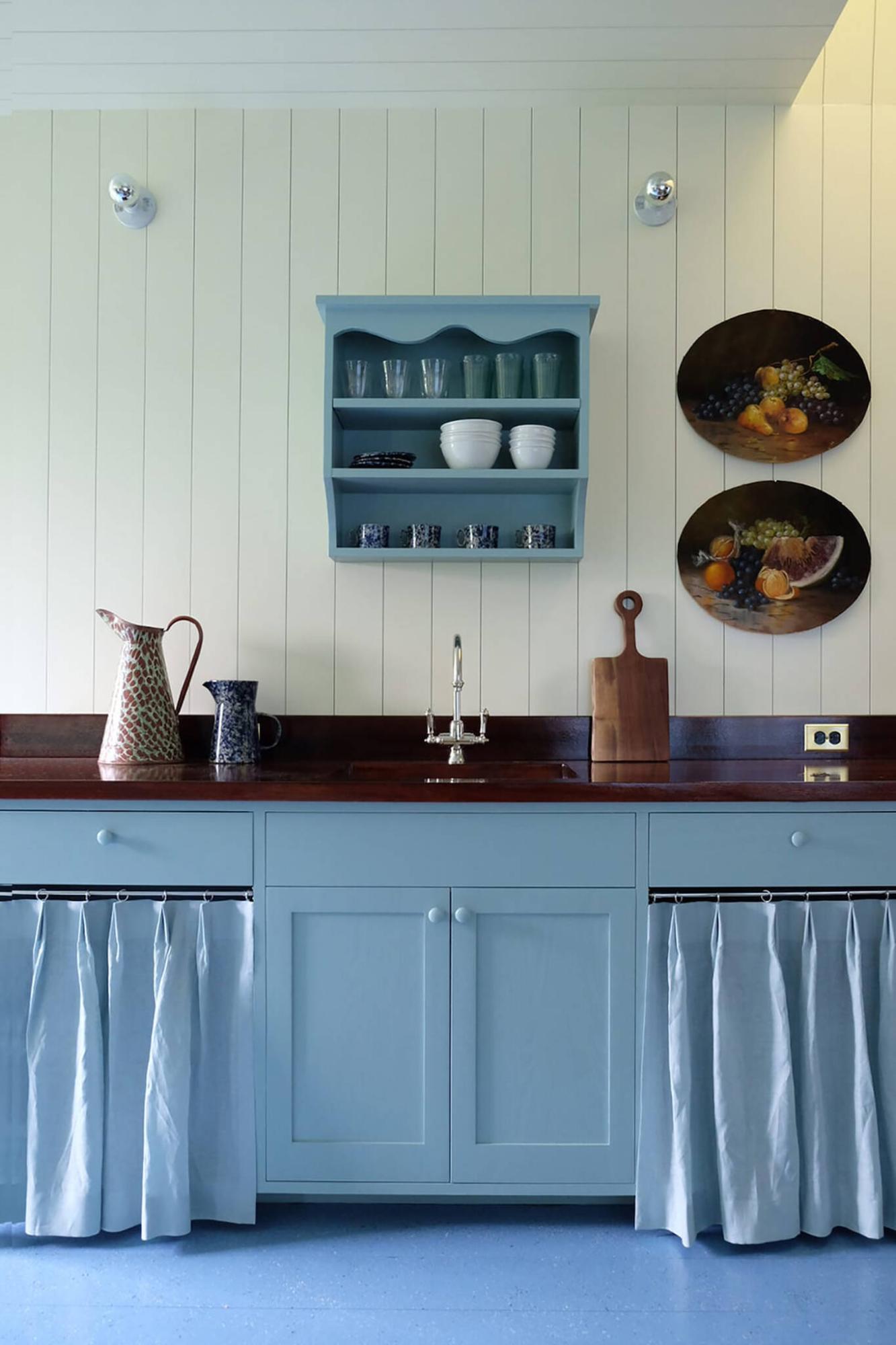
Peter Dolkas
To avoid getting the fabric dirty, hang the skirt just above the floor.
Skirted sinks and cabinets seem to be popping up everywhere — a flouncy miniskirted sink in the pages of House & Garden; a luxuriantly gathered utility room skirt on the cover of Schumacher’s glossy Frederic; a gingham-draped island in actress Lily Allen’s home. These skirts are chic, fresh and modern, rather than stuffy or country bumpkin.
The decorative skirt, it seems, is back.
Interior designer Leanne Ford is a fan, using them on cabinets in her own Pittsburgh home. “The truth is a sink skirt is almost always brought on by necessity — whether it be a unique sink shape, vintage cabinets, a tight budget, or just a lazy way to hide pipes,” she says. “But even though it comes from necessity, the beauty a skirt offers is uniquely its own. Opting for a skirt instead of a cabinet really creates a layer of warmth, style and texture to an otherwise sometimes cold room.”
They can also be a quick solution during renovations. “Vintage sinks cannot just be popped into a big box cabinet,” Ford says. Custom cabinetry is a sizable project, but you can whip up a skirt in an afternoon. They’re also affordable; even the most expensive fabric is likely to be cheaper than cabinetry.
Sometimes a skirt is a more intentional part of the design concept. When designing a guesthouse for a client in Litchfield County, Conn., Peter Dolkas wanted to add softness to a kitchen that was open to the main living space. “There were plans for the cabinetry from the contractor and we actually removed some to add skirts instead. We just felt like it was a lot more appropriate for the setting of a little cottage,” says Dolkas, who co-founded Brooklyn-based interior design firm Studio Dorion with Michelle Ficker. But Dolkas points out that, in this case, the skirt was also practical: The homeowners wanted to keep the kitchen clear of appliances but still have them readily available. Skirts allowed for easy access.
Sean Symington, an interior designer who splits his time between England and Toronto, likes using a skirt to conceal plumbing below pedestal sinks. They can also hide extra toiletries. Symington also recently used a fabric skirt to conceal laundry appliances in a new-build home. “This property had a utility room located directly off the kitchen breakfast area, which meant that the washing machine and dryer were on full display,” says Symington, who decided to hide them with a gathered curtain. His goal was not only to conceal, but to add warmth. “We wanted to distract from the ‘builder-basic’ finishes without going to the expense of replacing anything,” says Symington.
Whether you’re trying to hide an eyesore, craving a new look or just want to add more storage, a skirt might be the answer. Here’s what you need to know about embracing the skirted look.
Pick a practical fabric
While British designer Beata Heuman once famously draped a sink in a paisley velvet skirt, you’re going to want a fabric that can be laundered, Dolkas says. Nancy Johnson, the content creator behind The Hillside House, also recommends a lighter fabric such as quilting cotton, which “allows for prettier and tighter pleats and a flowy, soft skirt.” She also suggests prewashing fabrics in case they shrink.
Mind the hem
Precise measuring is key. If you don’t want to be constantly washing a dirty hem, make sure the skirt skims just above the floor rather than puddling on it. If you’ll be using curtain rings to hang the fabric, don’t forget to account for their size when determining the length.
Aim for fullness
Part of the charm of a skirted sink lies in the way the fabric drapes. To get some fullness you’ll need 1½ to two times the width of the opening you plan to skirt. Additionally, Symington says, it’s a good idea to make the skirt in two panels, so you can open the curtains to either side to access what is underneath.
Dolkas suggests adding pinch pleats for structure. To create a flounce, copy Symington’s trick of having a seamstress sew the pocket a few inches from the top, leaving a flap of fabric to hang down. If you’re handy with a sewing machine, Johnson says you can sew in pleats using a universal ruffler foot, then iron them down and sew across all the pleats further down for a graduated pleat.
Secure your skirt
For cabinetry, a tension rod can hold a skirt in a pinch, but it may not stand up to daily handling. Instead, Dolkas prefers the cafe curtain hardware from Rejuvenation, which is available in inside and outside mounted styles. For a pedestal sink, Johnson suggests using a heavy-duty self-adhesive Velcro attached to both the skirt and sink. Or, Dolkas says, you could use strong magnets to secure fabric to a cast iron sink.



